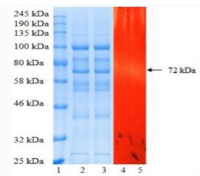Partial Purification and Characterization of Endoxylanase from a fungus, Leohumicola incrustata
Main Article Content
Abstract
Xylanases are glycoside hydrolases (GH) that degrade β-1,4-xylan, a linear polysaccharide found a hemicellulose in cell wall of plants. Endoxylanase (Endo-1,4-β-xylanase, EC 3.2.1.8) randomly catalyses xylan to produce varying short xylooligosaccharides (XOS). This study aimed to determine the characteristics of a partially purified endoxylanase from Leohumicola incrustata. Enzyme production was
carried out using beechwood (BW) xylan, after which the cell-free crude filtrate was concentrated using the ammonium sulphate precipitation method. The hydrolysed products were analysed by thin-layer chromatography (TLC) and zymography. The result showed that the enzyme produced varying smallersized linear xylooligosaccharides with Rf values corresponding to those of xylobiose, ylotriose,
xylotetraose, xylopentaose, xylohexaose and other higher oligomers. The endoxylanase had a molecular mass of 72 kDa. The enzyme is stable in the presence of K+ , Na+ , Ca2+, Fe2+, Mg2+, Zn2+, Co2+, pH of 5.0 and temperature of 37oC. However, the activity gradually decreased after 60 min at 50oC and retained over 69% activity after 120 min, while at 60 and 70oC, the enzyme activity sharply decreased (pre-incubation periods). Endoxylanase from L. incrustata is comparable to those of other microorganisms and should be considered an attractive candidate for future industrial applications.
Downloads
Article Details

This work is licensed under a Creative Commons Attribution-NonCommercial-NoDerivatives 4.0 International License.
References
Abbas, A., Ahmad, S., Mushtaq, Z. and Jamil, A. (2012). Partial purification and characterisation of xylanase from Trichoderma harzianum. Journal of the Chemical Society of Pakistan, 34:1455- 1459.
Bradford, M.M. (1976). A rapid and sensitive method for the quantitation microgram quantities of protein utilising the principle of protein-dye binding. Analytical Biochemistry, 72: 248–254.
Burke, R.M., Cairney and J.W.G. (1997a). Purification and characterisation of a βl,4-endoxylanase from the ericoid mycorrhizal fungus Hymenoscyphus ericae. New Phytologist, 135:345–352.
Chakdar, H., Kumar, M., Pandiyan, K., Singh, A., Nanjappan, K., Kashyap, P.L. and Srivastava, A.K. (2016). Bacterial xylanases: biology to biotechnology. 3 Biotechnology, 6: 1-15.
Chen, H. (2014). Biotechnology of lignocellulose: Theory and practice, Biotechnology of Lignocellulose: Theory and Practice. pp. 25-71.
Chen, H.G., Yan, X., Liu, X.Y., Wang, M.D., Huang, H.M., Jia, X.C. and Wang, J.A. (2006). Purification and characterisation of novel bifunctional xylanase, XynIII, isolated from Aspergillus niger A-25. Journal of Microbiology Biotechnology, 16: 1132-1138.
Corral, L.O. and Villaseñor-Ortega, F. (2006). Xylanases. Advances in Agric-Food Biotechnology, 661: 305-322.
Freixo, M.R. and De Pinho, M.N. (2002). Enzymatic hydrolysis of beechwood xylan in a membrane reactor. Desalination 149: 237-242.
Gírio, F.M., Fonseca, C., Carvalheiro, F., Duarte, L.C., Marques, S. and Bogel-Łukasik, R. (2010). Hemicelluloses for fuel ethanol: A review. Bioresource Technology, 101: 4775–4800.
Goncalves, G.A.L., Takasugi, Y., Jia, L., Mori, Y., Noda, S., Tanaka, T., Ichinose, H. and Kamiya, N. (2015). Synergistic effect and application of xylanases as accessory enzymes to enhance the hydrolysis of pretreated bagasse. Enzyme Microbial Technology,72: 16-24.
Hmida-Sayari, A., Taktek, S., Elgharbi, F. and Bejar, S. (2012). Biochemical characterisation, cloning and molecular modelling of a detergent and organic solvent-stable family 11 xylanases from the newly isolated Aspergillus niger US368 strain. Process Biochemistry 47: 1839-1847.
Hong, P.Y., Iakiviak, M., Dodd, D., Zhang, M., Mackie, R.I. and Cann, I. (2014). Two new xylanases with different substrate specificities from the human gut bacterium Bacteroides intestinalis DSM 17393. Applied and Environmental Microbiology, 80:2084-2093.
Juturu, V. and Wu, J.C. (2011). Microbial xylanases: Engineering, production and industrial applications.Biotechnology Advances, 30: 1219-1227.
Kamble, R.D. and Jadhav, A.R. (2012). Isolation, purification, and characterisation of xylanase produced by a new species of Bacillus in solid state fermentation. International Journal of Microbiology, 2012: 1-8.
Kusuda, M., Ueda, M., Konishi, Y., Matsuzawa, K., Shirasaka, N., Nakazawa, M., Miyatake, K. and Terashita, T. (2004). Characterisation of extracellular glucoamylase from the ectomycorrhizal mushroom Lyophyllum shimeji. Mycoscience, 45:383-389.
Liao, H., Zheng, H., Li, S., Wei, Z., Mei, X., Ma, H., Shen, Q. and Xu, Y. (2015). Functional diversity and properties of multiple xylanases from Penicillium oxalicum GZ-2. Scientific Reports 5: 12631.
Liu, L., Wang, L., Zhang, Z., Guo, X., Li, X. and Chen, H. (2012). Domain-swapping of mesophilic xylanase with hyperthermophilic glucanase. BMC
Biotechnology, 12: 1-7.
Miller, G.L. (1959). Use of dinitrosalicylic acid reagent for determination of reducing sugar. Analytical Chemistry, 31: 426- 428.
Polizeli, M.L.T.M., Rizzatti, A.C.S., Monti, R., Terenzi, H.F., Jorge, J.A. and Amorim, D.S. (2005). Xylanases from fungi: properties and industrial applications. Applied Microbiology and Biotechnology, 67: 577-591.
Ratanakhanokchai, K., Kyu, K.L. and Tanticharoen, M. (1999). Purification and properties of a xylan-binding endoxylanase from alkaliphilic Bacillus
sp. strain K-1. Applied and Environmental Microbiology, 65: 694- 697.
Saha, B.C. (2003). Hemicellulose bioconversion. Journal of Industrial Microbiology and Biotechnology, 30: 279-291.
Sakthiselvan, P., Naveena, B. and Partha, N. (2014). Molecular characterisation of a xylanase-producing fungus isolated from fouled soil. Brazilian Journal of Microbiology, 45: 1293-1302.
Subramaniyan, S. and Prema, P. (2002). Biotechnology of microbial xylanases: enzymology, molecular biology and application. Critical Reviews in
Biotechnology, 22: 33-46.
Takahashi, Y., Kawabata, H. and Murakami, S. (2013). Analysis of functional xylanases in xylan degradation by Aspergillus niger E-1 and characterisation of the GH family 10 xylanase XynVII. SpringerPlus, 2: 447.
Yun, K., Yopi and Meryandini, A. 2015. Characterisation of xylanase activity produced by Paenibacillus sp. XJ18 from TNBD Jambi, Indonesia. Hayati Journal of Biosciences, 22: 20-26.


